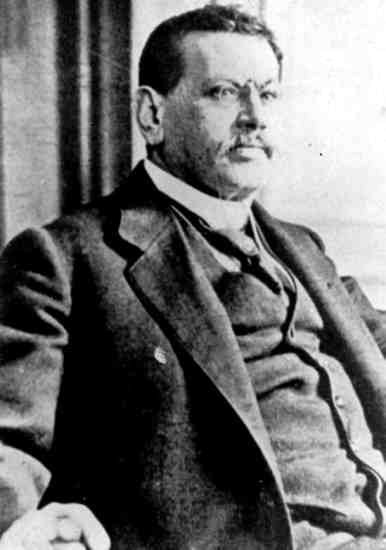The Treaty of Versailles was the most important of the peace treaties that brought the state of war between Germany and the Allied Powers, World War I, to an end. It was signed on 28 June 1919 in Versailles, exactly five years after the assassination of Archduke Franz Ferdinand, which had directly led to the War. The other Central Powers on the German side of World War I signed separate treaties. Although the armistice, signed on 11 November 1918, ended the actual fighting, it took six months of Allied negotiations at the Paris Peace Conference to conclude the peace treaty. The treaty was registered by the Secretariat of the League of Nations on 21 October 1919.

Hugo Preuß. (1860-1925)
One man was forever altered by the events of the “November Criminals”, those within the newly formed Weimar Government who “signed the country away” on that day in 1919. Of all the “November Criminals”, this man had a particular hatred toward the Jewish politician and primary architect of the Weimar Constitution Hugo Preuss. And although at the time a former soldier in the Prussian Army and current revolutionary in the people’s socialist revolt, this man would be forever altered by the forced negotiations that resulted in his country’s alignment with Allied principles.
That man was Private Adolf Hitler and very soon the world would be given an opportunity to look into the deeply disturbed mind of this man through his own words; Mein Kampf.
The “signing away of the German People” took on many forms, but none as controversial as the Article 231. Later known as the “War Guilt Clause”, the article required “Germany [to] accept the responsibility of Germany and her allies for causing all the loss and damage” during the war (the other members of the Central Powers signed treaties containing similar articles). The treaty required Germany to disarm, make ample territorial concessions, and pay reparations to certain countries that had formed the Entente powers. In 1921 the total cost of these reparations was assessed at 132 billion marks (then $31.4 billion or £6.6 billion, roughly equivalent to US $442 billion or UK £284 billion in 2019). At the time economists, notably John Maynard Keynes (a British delegate to the Paris Peace Conference), predicted that the treaty was too harsh—a “Carthaginian peace”—and said the reparations figure was excessive and counter-productive, views that, since then, have been the subject of ongoing debate by historians and economists from several countries. On the other hand, prominent figures on the Allied side such as French Marshal Ferdinand Foch criticized the treaty for treating Germany too leniently.
The result of these competing and sometimes conflicting goals among the victors was a compromise that left no one content: Germany was neither pacified nor conciliated, nor was it permanently weakened. The problems that arose from the treaty would lead to the Locarno Treaties, which improved relations between Germany and the other European powers, and the re-negotiation of the reparation system resulting in the Dawes Plan, the Young Plan, and the indefinite postponement of reparations at the Lausanne Conference of 1932.
All of these events played upon the mind of the young soldier, forcing him to find answers to his questions among the biases of the time; the greatest of which being German Antisemitism. This [Antisemitism] was not something that simply came as a result of the war. On the contrary, the Germanic peoples have a long and disturbing history of antisemitism, as did many non-Jews throughout 18th, 19th and 20th century Europe. Its prevalence as a part of the cultural psyche of the continent made it easy for a young Hitler to utilize this cultural bias, already well-established among the socialist-fearing right, and turn it into an all-out war against an entire race. In his book The Death of Democracy, the author Benjamin Carter Hett discusses the root of Hitler’s hatred toward the Jews.
“In Mein Kampf, he [Hitler] claims that he developed his antisemitism in prewar Vienna. He illustrated the point with a story of encountering a foreign-looking “phenomenon” in Vienna’s inner city, with “long kaftan and black locks.” His first thought, so he claimed, was to wonder, “Is this also a Jew?” Hitler watched the man “stealthily and carefully; but the longer I stared at this foreign face and examined it feature by feature, the more the first question reshaped itself in my mind…Is this a German?” Driven by this experience, Hitler began to study the “Jewish question” and, he writes, to recognize the “destructive” influence of Jews in all aspects of politics, social life, journalism, and the arts. “Gradually,” he writes, “I began to hate them”
Hett continues…
“Many of Hitler’s toxic expressions of hatred for Jews after 1919 can be traced to specific newspapers, pamphlets, and books that he read in Vienna before 1913. Certainly, he absorbed the distinctive Viennese antisemitism of that time. But there is no evidence that he actually held these views until later, while considerable evidence points to his many friendships with Jews, both in Vienna and in the army during the war, and his respect for Jewish culture in general. The hatred seems to have remained latent, like a photographic image waiting for developing solution.”
That “developing solution” would come in the form of tears and blood shed over the ensuing decades leading up to the horrors that would ultimately be called “The Holocaust”.